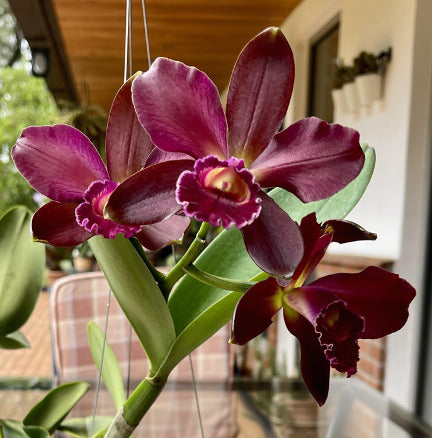Kalapana Orchid Farm
Rlc. Volcano Plum ‘Kilauea’
Rlc. Volcano Plum ‘Kilauea’
Couldn't load pickup availability
Rlc. Volcano Plum ‘Kilauea’ is a remarkable hybrid that commands attention with its deeply saturated, velvety flowers. The blooms are a rich, uniform wine-red or deep plum-purple. The petals and sepals are broad and have a heavy, waxy substance. The ruffled lip is even darker, often appearing almost black-purple, with two small, contrasting bright yellow "eyes" deep in the throat. This plant is a reliable bloomer, often producing fragrant flowers in clusters of two or three. The plant itself is a robust, compact grower with thick pseudobulbs and leathery, medium-green leaves.
Quick Start
Light: Bright, filtered light (2500-4000 foot-candles). Temps: Intermediate to warm. 60-70°F nights and 75-85°F days. Water: Water thoroughly when the media is almost or completely dry. Humidity: Prefers 50-70%. Fertilizer: Apply a balanced fertilizer regularly during active growth. Media: Very coarse and open mix (e.g., large-grade fir bark, lava rock).
🌺 Orchid Lore & Discovery
This orchid has deep roots in Hawaiian breeding. Rlc. Volcano Plum was registered by Miyamoto Orchids (Oahu, Hawaii) in 1993. It is a cross between Rlc. Volcano Gold and Cattleya Plum Luedde. This lineage was created to produce compact plants with large, fragrant, and intensely colored blooms. The cultivar ‘Kilauea’ is a select clone named after the Kilauea volcano on the Big Island of Hawaii. The name is a perfect fit, as the flower's deep, smoldering reddish-purple tones evoke the color of molten lava and cooled volcanic rock.
🌿 How to Grow Rlc. Volcano Plum ‘Kilauea’
Light This Cattleya requires bright, indirect light to flower successfully. An east-facing window that provides direct morning sun is an excellent location. If grown in a south or west-facing window, it must be protected by a sheer curtain or placed back from the glass to prevent the leaves from burning. The leaves should be a light, olive-green color when lighting is optimal.
Temperature This orchid thrives in intermediate to warm conditions. Ideal daytime temperatures are between 75-85°F, with a nighttime drop to 60-70°F. A 10-15°F differential between day and night is beneficial and helps to initiate flowering. It is not cold-hardy and should be protected from temperatures below 55°F.
Water Proper watering involves a "wet/dry" cycle. When you water, drench the pot thoroughly, letting water flush freely through the media. Afterward, you must allow the media to become almost completely dry before watering again. The plant's thick pseudobulbs store water, making it quite resilient to short periods of drought.
Humidity For optimal growth, maintain humidity levels between 50% and 70%. In standard home environments, this can be achieved by using a humidifier or by placing the plant on a humidity tray (a tray of wet pebbles, ensuring the pot does not sit directly in the water). Good air circulation from a fan is important to prevent fungal issues.
Media & Potting An extremely coarse, fast-draining potting mix is essential. The thick roots of this hybrid need abundant air. A mix of large-grade fir bark, lava rock, and charcoal is a classic and effective choice. Repot this plant only when necessary (every 2-3 years), either when the media has decomposed or when the plant is growing out of its pot. The best time to repot is when new roots are just beginning to emerge from the base of the newest pseudobulb.
Currently available in blooming size only.
Share


